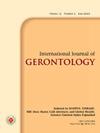Association between Gait Time and Cognitive Function in Various Walking Conditions
IF 0.3
4区 医学
Q4 GERIATRICS & GERONTOLOGY
引用次数: 1
Abstract
Introduction: Walking ability has been emerges as a significant predictor of future cognitive impairment and dementia in elderly. This study aimed to investigate the association between gait time and cognitive function in various walking conditions, and to find out which walking conditions are the most associated with cognitive function. Methods: This is a study with a cross-sectional design and convenience sampling. The study participants were 86 elderly people aged > 65 years with cognitive intact or mild cognitive impairment. Cognitive function was measured using Mini-mental state examination (MMSE), and two examiners measured walking time according to six different walking conditions. Pearson's correlation analysis and multiple regression analysis were used to compare the association between gait time and cognitive function in six walking conditions. Results: There are significantly correlated between gait time and MMSE (cognitive function) in all walking conditions (p < 0.05). According to multiple linear regression, all of the gait time in six different walking conditions was associated with the cognitive function (p < 0.05). However, age, sex, body mass index (BMI), and leg lengths did not associated with the cognitive function. The walking condition that had highest adjusted R^2 (%) coefficient and satisfied the homoscedasticity of residuals was the 4-Meter Walking Test (4MWT) while holding a water cup (r = 0.483, p < 0.001) and the Groningen Meander Walking Test (GMWT) (r = 0.473, p < 0.001). Conclusion: Among the six walking models, the 4MWT while holding a water cup and GMWT were the most effective walking models to explain the cognitive function.不同步行条件下步态时间与认知功能的关系
导读:行走能力已成为老年人未来认知障碍和痴呆的重要预测指标。本研究旨在探讨不同步行状态下步态时间与认知功能的关系,并找出哪些步行状态与认知功能的关系最大。方法:本研究采用横断面设计,方便抽样。该研究的参与者是86名年龄> 65岁的认知完整或轻度认知障碍的老年人。采用简易心理状态测试(MMSE)测量认知功能,两名考官根据六种不同的步行条件测量步行时间。采用Pearson相关分析和多元回归分析比较6种步行状态下步态时间与认知功能的相关性。结果:在所有步行条件下,步态时间与认知功能(MMSE)均有显著相关(p < 0.05)。经多元线性回归分析,6种不同行走状态下的步态时间均与认知功能相关(p < 0.05)。然而,年龄、性别、身体质量指数(BMI)和腿长与认知功能无关。调整后R^2(%)系数最高并满足残差均方差的行走工况为举水杯行走4米试验(R = 0.483, p < 0.001)和格罗宁根曲径行走试验(R = 0.473, p < 0.001)。结论:在6种步行模型中,抱水杯步行模型和抱水杯步行模型是解释认知功能最有效的步行模型。
本文章由计算机程序翻译,如有差异,请以英文原文为准。
求助全文
约1分钟内获得全文
求助全文
来源期刊
CiteScore
0.60
自引率
0.00%
发文量
0
审稿时长
6-12 weeks
期刊介绍:
The Journal aims to publish original research and review papers on all fields of geriatrics and gerontology, including those dealing with critical care and emergency medicine.
The IJGE aims to explore and clarify the medical science and philosophy in all fields of geriatrics and gerontology, including those in the emergency and critical care medicine. The IJGE is determined not only to be a professional journal in gerontology, but also a leading source of information for the developing field of geriatric emergency and critical care medicine. It is a pioneer in Asia.
Topics in the IJGE cover the advancement of diagnosis and management in urgent, serious and chronic intractable diseases in later life, preventive medicine, long-term care of disability, ethical issues in the diseased elderly and biochemistry, cell biology, endocrinology, molecular biology, pharmacology, physiology and protein chemistry involving diseases associated with age. We did not limit the territory to only critical or emergency condition inasmuch as chronic diseases are frequently brought about by inappropriate management of acute problems.

 求助内容:
求助内容: 应助结果提醒方式:
应助结果提醒方式:


